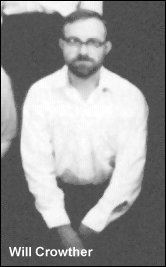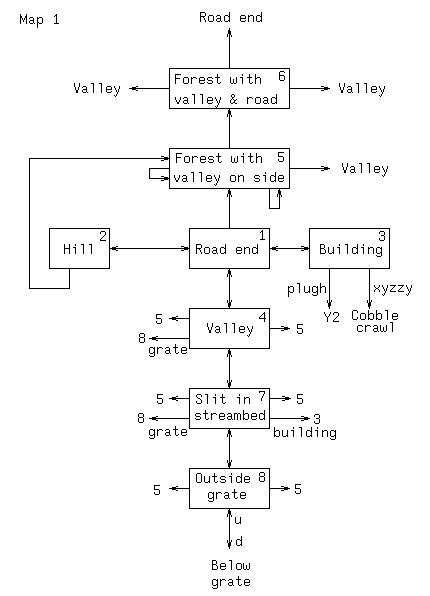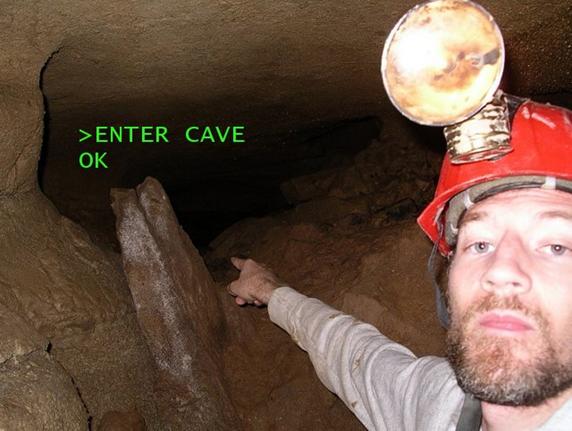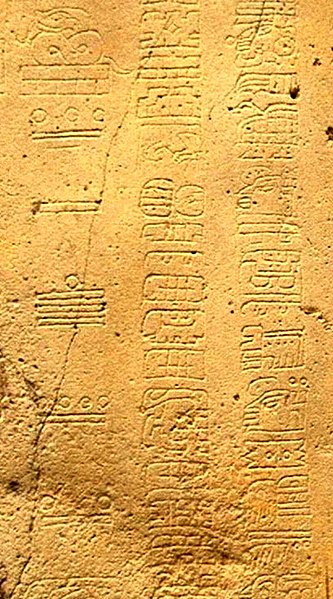Colossal Cave Adventure is a text based adventure game developed back in the 1970's by William Crowther. To the best of my knowledge, the game was originally written in FORTRAN in 1975, and then later ported to other languages due to its wild popularity. The basic idea behind Colossal Cave Adventure is that you key in specific commands that the console understands to navigate the caves. For example, if I wanted to go south, then I would type "SOUTH" into the console and I would arrive at a different location on the map (provided South is a valid direction from that specific part of the map). The interesting thing about Crowther was one of the founders of the ARPANET, one of the corner stones of today's global Internet. The idea for Adventure was spawned from Crowther's passion for cave exploration, and in fact, Colossal Cave Adventure's map emulates parts of the maps Crowther created of Mammoth Cave for the Cave Research Foundation.
Colossal Cave Adventure was then picked up a year later by a man by the name of Don Woods, who expanded on the Crowther's work after first receiving his approval. Woods's version was still written in FORTRAN, but it wasn't until Jim Gillogly of the Rand Corporation (another co-developer of the global Internet we use today), that Collossal Cave Adventure was ported to C. It is this release that became the official release of "Adventure", and was included with the first IBM PC's. At the time, this was the single most advanced implementation of game logic, and spawned several other text based adventure games including ZORK, and Hitchhiker's Guide to the Galaxy.
So why all the history? I bring up the subject of Adventure Game because it is now my turn to write my own text based adventure game for my Computer Science class. The game that so changed the text based adventure genre, has now been relegated to a rudimentary assignment in an Intro to Computer Science class. I am neither saddened by this, nor am I overjoyed by the prospect. I simply find the rich history that is involved in the development of the technology we know and love today amazing. Here we have a story within a story. On one hand, we have a tale of a technology (the Internet) being developed that will change the way mankind communicates forever. On the other, just beneath the surface in fact, we have a tale of a man who was at the forefront of developing this technology, yet on the side he develops something that would captivate the mind of his users for decades to come. And why did Crowther develop such a masterpiece of its day? Was it for money? Recognition? Boredom? Try love; the love for his two daughters whom he wanted to feel more connected to. Who could have guessed that his daughters would love their father's work so much, that they would proceed to pass it around amongst their friends and in doing so, establish a whole new genre of entertainment?
And that is my point of this post. No matter what you do. No matter what your industry of expertise may be. Be sure that all that you do is out of the love and passion, and the will to right by others. A simple act of kindness can, and often does, change the world. I shall leave you now with the original Colossal Cave Adventure. Click the image above and the console will open in a new window. As this is a Java version of the game, you will need to be sure Java is enabled in your browser to play. There is a walkthrough, but try to play the game first without it, and then use the walkthrough to fill in the gaps. Half the fun of Adventure is figuring out the puzzles for yourself. Enjoy :)
Wednesday, January 18, 2012
Saturday, January 7, 2012
Crafting the Perfect Villian
***Public Disclosure***
The opinions expressed herein are just that, opinion. I encourage everybody who reads this to comment and share your thoughts on the subject matter. You are equally encouraged to subscribe to this blog and make your readership known. Suggestions on blogging topics are always welcome, as is the open sharing of resources. That being said, regardless of whether or not you choose to share your input, I humbly thank you for reading my work and hope you will continue to do so in the future.
Mahalo for your support :)
**********************************************************************************
Last night I finally had the opportunity to watch Sherlock Holmes: A Game of Shadows. I had the pleasure of watching the brilliant Sherlock Holmes and the brilliantly mad Professor James Moriarty do battle on the silver screen in a fashion that I haven't seen captured in a very long time. It was akin to that of two Roman gladiators matching whits in the Coliseum. Not a game of cat and mouse. Not a crucible where there must be one winner and one loser. No, this was something else entirely. The battle between Holmes and Moriarty is and has always been one of equals. It is the perfect dichotomy between protagonist and antagonist, and meets its end as only a relationship of this caliber can.
Putting all this aside; however, Holmes and Moriarty's relationship got the cogs in the inner recesses of my mind turning. And so I pose the question, what makes the "perfect" villain? Is it how he or she carries him or herself? Is it the way he or she speaks? Is it the villain's malevolent acts towards the protagonist's of the story? Is it the way he or she dresses? I would argue that it is none of these things, and that the reason why many villains come off as flat and predictable is due to the fact that the villain's character was designed with these attributes in mind.
On the contrary, it seems to me that what makes the perfect villain perfect is the relationship he or she has with the hero or heroes of the story. The perfect villain antagonizes the hero because that is what a villain is designed to do. And how does a villain go about this antagonism? But by studying its subject carefully, intimately. I speak of the character as if he or she were real, and therein lies the key. The villain, in order to be effective, must be somebody that the reader or viewer can relate to. Too often emphasis is put on the reader being able to relate to the hero, but it is the villain that should embody every dark thought and desire the reader has. The villain is the personification of every time the reader wanted to throw their boss through the sixth story window, and every time he or she felt jilted by a former lover. For every time they were ever wronged, hurt, or oppressed, the villain represents the manifestation of those feelings.
And what of the hero? How does the hero fit into the equation of the villain? The hero in turn represents the reader's desire to make atonement for these feelings. The hero represents normalcy. Few heroes that I have had the pleasure of creating were the most upstanding citizens; and they didn't need to be. Doing right by the world is not a prerequisite of the written hero. Matter of factly, the idea of a "do-gooder" rarely appeals to our human sensibilities. Sherlock Holmes is a fine example of this. He drinks. He smokes. He does drugs. He makes mistakes. Yet his defining characteristic that makes him a hero is in fact his relationship with the villain. Sherlock Holmes and Professor Moriarty are the same in every respect, except for one key difference. While Holmes seeks to bring balance to the chaotic world that ensues when a puzzle presents itself, Moriarty seeks to unbalance the world.
How does all this create the vision of the perfect villain? Quite simply, if there is no conflict, then there is no hero. And if there is no hero, then there cannot be a villain, or at least a villain that is effective in the eyes of the reader. The two are co-dependent upon each other. They feed on the strengths and weaknesses of the other, thus creating depth, emotion, a soul. And so we come full circle and see that the perfect villain is one who reveals the imperfections of the hero.
To all the aspiring writers out there, consider this the next time you attempt to craft your antagonist. Look past his or her demeanor, attire, and actions, and instead examine the relationship he or she shares with the hero. Build your antagonist from there. Then, and only then, will your villain truly be worthy of the hero's remorse. Then, and only then, will your villain truly be "perfect".
The opinions expressed herein are just that, opinion. I encourage everybody who reads this to comment and share your thoughts on the subject matter. You are equally encouraged to subscribe to this blog and make your readership known. Suggestions on blogging topics are always welcome, as is the open sharing of resources. That being said, regardless of whether or not you choose to share your input, I humbly thank you for reading my work and hope you will continue to do so in the future.
Mahalo for your support :)
**********************************************************************************
Last night I finally had the opportunity to watch Sherlock Holmes: A Game of Shadows. I had the pleasure of watching the brilliant Sherlock Holmes and the brilliantly mad Professor James Moriarty do battle on the silver screen in a fashion that I haven't seen captured in a very long time. It was akin to that of two Roman gladiators matching whits in the Coliseum. Not a game of cat and mouse. Not a crucible where there must be one winner and one loser. No, this was something else entirely. The battle between Holmes and Moriarty is and has always been one of equals. It is the perfect dichotomy between protagonist and antagonist, and meets its end as only a relationship of this caliber can.
Putting all this aside; however, Holmes and Moriarty's relationship got the cogs in the inner recesses of my mind turning. And so I pose the question, what makes the "perfect" villain? Is it how he or she carries him or herself? Is it the way he or she speaks? Is it the villain's malevolent acts towards the protagonist's of the story? Is it the way he or she dresses? I would argue that it is none of these things, and that the reason why many villains come off as flat and predictable is due to the fact that the villain's character was designed with these attributes in mind.
On the contrary, it seems to me that what makes the perfect villain perfect is the relationship he or she has with the hero or heroes of the story. The perfect villain antagonizes the hero because that is what a villain is designed to do. And how does a villain go about this antagonism? But by studying its subject carefully, intimately. I speak of the character as if he or she were real, and therein lies the key. The villain, in order to be effective, must be somebody that the reader or viewer can relate to. Too often emphasis is put on the reader being able to relate to the hero, but it is the villain that should embody every dark thought and desire the reader has. The villain is the personification of every time the reader wanted to throw their boss through the sixth story window, and every time he or she felt jilted by a former lover. For every time they were ever wronged, hurt, or oppressed, the villain represents the manifestation of those feelings.
And what of the hero? How does the hero fit into the equation of the villain? The hero in turn represents the reader's desire to make atonement for these feelings. The hero represents normalcy. Few heroes that I have had the pleasure of creating were the most upstanding citizens; and they didn't need to be. Doing right by the world is not a prerequisite of the written hero. Matter of factly, the idea of a "do-gooder" rarely appeals to our human sensibilities. Sherlock Holmes is a fine example of this. He drinks. He smokes. He does drugs. He makes mistakes. Yet his defining characteristic that makes him a hero is in fact his relationship with the villain. Sherlock Holmes and Professor Moriarty are the same in every respect, except for one key difference. While Holmes seeks to bring balance to the chaotic world that ensues when a puzzle presents itself, Moriarty seeks to unbalance the world.
How does all this create the vision of the perfect villain? Quite simply, if there is no conflict, then there is no hero. And if there is no hero, then there cannot be a villain, or at least a villain that is effective in the eyes of the reader. The two are co-dependent upon each other. They feed on the strengths and weaknesses of the other, thus creating depth, emotion, a soul. And so we come full circle and see that the perfect villain is one who reveals the imperfections of the hero.
To all the aspiring writers out there, consider this the next time you attempt to craft your antagonist. Look past his or her demeanor, attire, and actions, and instead examine the relationship he or she shares with the hero. Build your antagonist from there. Then, and only then, will your villain truly be worthy of the hero's remorse. Then, and only then, will your villain truly be "perfect".
Tuesday, January 3, 2012
End of the World or World Without End???
As we begin this new year, a number of questions stir in people's minds. Most are relatively benign: What does the year hold in store for me? How can I make this year different from the last? And on, and on.
But this year is already different, isn't it? This year is special. This year has been the subject of speculation for time beyond mind. 2012 has been called the year that marks the end of the world, but it has also been called the year that marks the end of the age. So which is it? Without calling bias into the nature of this article, I would like to attempt to outline some of the eschatological theories associated with the end of the Long Count Calendar.
The Mesoamerican Long Count Calendar is a 5,125 year long calendar of unknown origin. Most scholars agree that the calendar is originally Olmec in design; however, a similar calendar was discovered in Egypt that predates the Olmecs settling Mesoamerica by about 650 years. Interestingly enough, both calendars are celestial in design and both calendars terminate in 2012. Both calendars consist of 360 day years, and both calendars are linear in design.This is counter to the popular depiction of a circular 365 day calendar that Mayanists portray, and assists in supporting the argument that the calendar does indeed have a finite termination date.
But what happens when this date is reached? Maybe nothing, and most experts would support this. Yet there is a disturbing commonality among ancient civilizations that used the stars to keep track of time; all of these calendars seem to terminate this year, and appear to be marked by some cataclysmic event that brings about the end of the world as we know it. I could stop there, but then I would fall into the trap that sensationalizes the whole concept of a 2012 Apocalypse. There is a key piece that many supporters of the 2012 phenomenon seem to omit, and that is the concept that as one world ends, a new world begins. As a matter of fact, according to the mythologies of many Native American tribes, there were three worlds prior to the one we live in now. If these legends are correct, then 2012 marks the end of the fourth world, and the beginning of the fifth. How this is brought about is anybody's guess, but many believe that this year shall be marked by a time of increased solar activity that triggers a series of natural disasters. Others speculate that an asteroid or comet will strike the Earth causing widespread damage. Perhaps most bizarre, is that some theorists speculate that the Earth will collide with an ancient celestial object (some identify this object as a planet) known as Nibiru. This is all theory, with very little evidence to back the claims. Of the two theories, the first seems slightly more realistic, as the sun is expected to reach a period of high solar activity sometime this year. Yet, civilizations far older than our own and spanning the entire world indicate 2012 with some exactitude. Here are just a few examples of what these civilizations have hailed 2012 as:
With so many similarities between predictions, it is possible that all of these cultures are correct to some degree. It is equally possible that none of these cultures are correct and 2012 will come and go just like any other year. There will be war, and pain, and destruction. But there will also be tenderness, hope, and perhaps even a little bit of joy. If these year is to mark our uprooting, then so be it, but let it not unhinge us. Let it not deliver us into the arms of despair. Let it instead unite us, and bring us closer to realizing what this world has seemed to have lost in the midst of all the uncertainty; its humanity. Happy New Year everybody. May it bring you blessings and prosperity beyond your wildest dreams.
But this year is already different, isn't it? This year is special. This year has been the subject of speculation for time beyond mind. 2012 has been called the year that marks the end of the world, but it has also been called the year that marks the end of the age. So which is it? Without calling bias into the nature of this article, I would like to attempt to outline some of the eschatological theories associated with the end of the Long Count Calendar.
The Mesoamerican Long Count Calendar is a 5,125 year long calendar of unknown origin. Most scholars agree that the calendar is originally Olmec in design; however, a similar calendar was discovered in Egypt that predates the Olmecs settling Mesoamerica by about 650 years. Interestingly enough, both calendars are celestial in design and both calendars terminate in 2012. Both calendars consist of 360 day years, and both calendars are linear in design.This is counter to the popular depiction of a circular 365 day calendar that Mayanists portray, and assists in supporting the argument that the calendar does indeed have a finite termination date.
But what happens when this date is reached? Maybe nothing, and most experts would support this. Yet there is a disturbing commonality among ancient civilizations that used the stars to keep track of time; all of these calendars seem to terminate this year, and appear to be marked by some cataclysmic event that brings about the end of the world as we know it. I could stop there, but then I would fall into the trap that sensationalizes the whole concept of a 2012 Apocalypse. There is a key piece that many supporters of the 2012 phenomenon seem to omit, and that is the concept that as one world ends, a new world begins. As a matter of fact, according to the mythologies of many Native American tribes, there were three worlds prior to the one we live in now. If these legends are correct, then 2012 marks the end of the fourth world, and the beginning of the fifth. How this is brought about is anybody's guess, but many believe that this year shall be marked by a time of increased solar activity that triggers a series of natural disasters. Others speculate that an asteroid or comet will strike the Earth causing widespread damage. Perhaps most bizarre, is that some theorists speculate that the Earth will collide with an ancient celestial object (some identify this object as a planet) known as Nibiru. This is all theory, with very little evidence to back the claims. Of the two theories, the first seems slightly more realistic, as the sun is expected to reach a period of high solar activity sometime this year. Yet, civilizations far older than our own and spanning the entire world indicate 2012 with some exactitude. Here are just a few examples of what these civilizations have hailed 2012 as:
- Hopi-25year period of purification, followed by End of Fourth World and beginning of the Fifth.
- Mayan-The end of Days
- Maori-Merging of the spiritual and physical worlds
- Zulu-The entire world will be flipped upside down
- Hindu-The end of time of man, and the coming of the "Enlightened Ones"
- Inca-The age of meeting ourselves again
- Aztec-A new race is born
- Pueblo-Emergence into the Fifth World
- Tibetan-The coming of the "Golden Age"
With so many similarities between predictions, it is possible that all of these cultures are correct to some degree. It is equally possible that none of these cultures are correct and 2012 will come and go just like any other year. There will be war, and pain, and destruction. But there will also be tenderness, hope, and perhaps even a little bit of joy. If these year is to mark our uprooting, then so be it, but let it not unhinge us. Let it not deliver us into the arms of despair. Let it instead unite us, and bring us closer to realizing what this world has seemed to have lost in the midst of all the uncertainty; its humanity. Happy New Year everybody. May it bring you blessings and prosperity beyond your wildest dreams.
Labels:
2012,
apocalypse,
aztec,
end of the world,
inca,
long calendar,
maya,
mesoamerica,
new year,
nibiru,
olmec,
prophecy
Subscribe to:
Comments (Atom)










